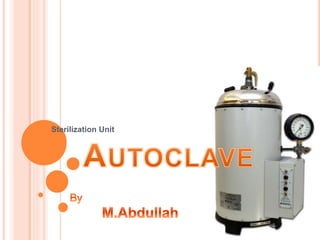
Sterilization Unit: Autoclave Guide
- 2. STERILIZATION Sterilization is a term referring to any process that removes or kills all forms of microbial organisms such as fungi, bacteria, viruses, spore forms, etc. present on a surface, contained in a fluid, or in a compound such as biological culture media. Sterilization can be achieved by applying heat, chemicals, irradiation, high pressure
- 3. AUTOCLAVE The autoclave is a equipment used to remove microorganisms (Virus, Bacteria, fungus etc.) and spores using high pressure and high temperature steam Sterilization Autoclave is a pressurized device designed to heat aqueous solutions above their boiling point at normal atmospheric pressure to achieve sterilization.
- 4. Auto Clave The name comes from Greek auto-, ultimately meaning self, and Latin clavis meaning key, thus a self-locking device. The autoclave was invented by Charles Chamberland in 1884. although a precursor known as the steam digester was created by Denis Papin in 1679
- 6. PRINCIPLE Boiling point of water is directly proportional to the pressure when the volume is constant. When pressure is increased in a closed vessel the temperature increases proportionately. i.e.for about 15 pounds of pressure per square inch (Psi) the temperature rises to 121oC. This pressure and temperature is kept constant for 20 minutes during autoclaving. It is sufficient to kill all the vegetative forms and spores of the organism.
- 7. THE RELATIONSHIP BETWEEN THE PRESSURE AND TEMPERATURE OF STEAM AT SEA LEVEL
- 8. Liquid Water cannot be heated above 100°C in an open vessel Water heated in a sealed vessel Pressure rises Boiling point of water is raised When the pressure higher than atmosphere a higher temperature than 1000C needs to boil the water. This steam contain higher energy than usual. Autoclaves make pressurized saturated steam in a chamber passing electrical current through a heating element in controlled manner. This energized steam take place required sterilization. This method is known as steam sterilization.
- 10. AUTOCLAVE USAGE PURPOSE OF THE AUTOCLAVE
- 11. AUTOCLAVE USAGE Microbiology Medicine Veterinary science Dentistry Metallurgy To prepare materials for bacteriological cell cultures(test tubes, pipettes, Petri dishes, etc.) without contamination. Prepare elements used for taking samples. (needles, tubes, containers). Sterilize contaminated material.
- 12. CONSTRUCTION A cylindrical vessel made of gun metal. Controller with time and temperature programmable by user. A backlit alphanumeric two line 32 character LCD display. Low water level, sensor open/short alarms and cut off. Lid is fitted with pressure gauge, safety valve, safety fusible plug manual exhaust valve, vacuum breaker.
- 13. Lid ensure an air tight closure in the autoclave. A perforated plate, which is used for keeping the material to be sterilized. Drain valve for easy draining and cleaning. Moulded Rubber Gasket and Stainless Steel carrier along with heater cover stand MAIN COMPONENTS 1. Heating Elements 2. Temperature Controller 3. Pressure Sensor 4. Chamber 5. Door gasket 6. Solenoid valve 7. Water level Sensor
- 14. HEATING ELEMENT
- 16. PRESSURE SENSOR
- 18. CHAMBER
- 19. SOLENOID VALVE
- 20. WORKING process
- 21. WORKING Most autoclaves contain - a sterilizing chamber to place articles - a steam jacket where steam is maintained. Steam flows from the steam jacket into the sterilizing chamber Cool air is forced out A special valve increases the pressure to 15 pounds/square inch above normal atmospheric pressure. The temperature rises to 121.5oC, The superheated water molecules rapidly conduct heat into microorganisms.
- 22. The time is reduced to 15 minutes to kill bacterial spore For denser objects, up to 30 minutes of exposure may be required. SCHEMATIC DIAGRAM OF AUTOCLAVE
- 23. TYPES OF STERILISATON Dry sterilization Wet sterilization
- 24. DRY STERILIZATION Mechanism: By destructive oxidation of essential cell constituents. Resistant spores requires a temperature of about 160 °C for 60 minutes. Employed for glassware; syringes, metal instruments and paper wrapped goods. Used for anhydrous fats, oils and powders that are impermeable to moisture.
- 25. WET STERILISATION Mechanism: By coagulating and denaturing enzymes and structural protein. Resistant spores generally requires 121 °C for 15-30 minutes. Used for the sterilization of culture media, and all other materials through which steam can penetrate. Moist heat is more effective than dry heat. Lower temperatures in a given time at a shorter duration.
- 26. DIFFERENT TYPES OF AUTOCLAVES Heat autoclaves: The most common source for autoclaving is heating. Here the autoclaves should maintain a temperature of at least 246 degrees for half an hour. Both dry heat or steam heat are used. For steam heat autoclaves, heated water vapors are used. Dry heat autoclaves are used for moisture sensitive surgical products or instruments. Gas autoclaves: Also known as chemicalves, gas autoclaves use a vapor solution to sterilize its contents. Formaldehyde gas and Ethylene oxide are the sterilizing agents used in gas autoclaves. They consume lesser heat and take lesser time to complete the cycle. Ultraviolet autoclaves: They produce UV light that kills the unwanted disease causing organisms.
- 27. Cold sterilization autoclaves: They use a cold sterilization liquid to sterilize the contents. Laboratory autoclaves: They are used for general lab work, component and stability testing, core hardening, drying glassware, and sterilizing. Stovetop autoclaves: In such autoclaves, the tools should always be separated to allow the steam to penetrate the load evenly. It is the simplest autoclave.